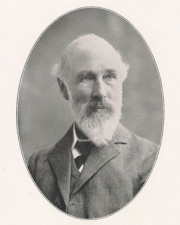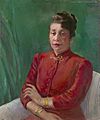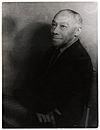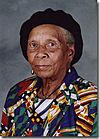William F. Barrett facts for kids
Quick facts for kids
William Fletcher Barrett
|
|
|---|---|
 |
|
| Born | 10 February 1844 Jamaica
|
| Died | 26 May 1925 (aged 81) |
Sir William Fletcher Barrett (10 February 1844 in Kingston, Jamaica – 26 May 1925) was an English physicist and parapsychologist.
Life
He was born in Jamaica where his father, William Garland Barrett, who was an amateur naturalist, Congregationalist minister and a member of the London Missionary Society, ran a station for saving African slaves. There he lived with his mother, Martha Barrett, née Fletcher, and a brother and sister. The family returned to their native England in Royston, Hertfordshire in 1848 where another sister, the social reformer Rosa Mary Barrett was born. In 1855 they moved to Manchester and Barrett was then educated at Old Trafford Grammar School.
Barrett then took chemistry and physics at the Royal College of Chemistry and then became the science master at the London International College (1867–9) before becoming assistant to John Tyndall at the Royal Institution (1863–1866). He then taught at the Royal School of Naval Architecture.
In 1873 he became Professor of Experimental Physics at the Royal College of Science for Ireland. From the early 1880s he lived with his mother, sister, and two live-in servants in a residence at Kingstown (now Dún Laoghaire). Barrett discovered Stalloy (see Permalloy), a silicon-iron alloy used in electrical engineering and also did a lot of work on sensitive flames and their uses in acoustic demonstrations. During his studies of metals and their properties, Barrett worked with W. Brown and R. A. Hadfield. He also discovered the shortening of nickel through magnetisation in 1882.
When Barrett developed cataracts in his later years, he also began to study biology with a series of experiments designed to locate and successfully analyze causative agents within the eyes. The result of these experiments was a machine called the entoptiscope. He was elected a Fellow of the Royal Society in June 1899 and was also a fellow of the Royal Society of Edinburgh and the Royal Dublin Society. He was knighted in 1912. He married Florence Willey in 1916. He died at home, 31 Devonshire Place in London.
Barrett's last book, Christian Science: An Examination of the Religion of Health was completed and published after his death in 1926 by his sister Rosa M. Barrett.
Psychical research
Barrett became interested in the paranormal in the 1860s after having an experience with mesmerism. Barrett believed that he had been witness to thought transference and by the 1870s he was investigating poltergeists. In September 1876 Barrett published a paper outlining the result of these investigations and by 1881 he had published preliminary accounts of his additional experiments with thought transference in the journal Nature. The publication caused controversy and in the wake of this Barrett decided to found a society of like-minded individuals to help further his research. Barrett held conference between 5–6 January 1882 in London. In February the Society for Psychical Research (SPR) was formed.
Barrett was a Christian and spiritualist member of the SPR. Although he had founded the society, Barrett was only truly active for a year, and in 1884 founded the American Society for Psychical Research. He became president of the society in 1904 and continued to submit articles to their journal. From 1908–14 Barrett was active in the Dublin Section of the Society for Psychical Research, a group which attracted many important members including Sir John Pentland Mahaffy, T.W. Rolleston, Sir Archibald Geikie, and Lady Augusta Gregory.
In the late 19th century the Creery Sisters (Mary, Alice, Maud, Kathleen, and Emily) were tested by Barrett and other members of the SPR who believed them to have genuine psychic ability, however, the sisters later confessed to fraud by describing their method of signal codes that they had utilized. Barrett and the other members of the SPR such as Edmund Gurney and Frederic W. H. Myers had been easily duped.
As a believer in telepathy, Barrett denounced the muscle reading of Stuart Cumberland and other magicians as "pseudo" thought readers.
Barrett helped to publish Frederick Bligh Bond's book Gate of Remembrance (1918) which was based on alleged psychical excavations at Glastonbury Abbey. Barrett endorsed the claims of the book and testified to Bond's sincerity. However, professional archaeologists and skeptics have found Bond's claims dubious.
In 1919, Barrett wrote the introduction to medium Hester Dowden's book Voices from the Void.
Dowsing
Barrett held a special interest in divining rods and in 1897 and 1900 he published two articles on the subject in Proceedings of the SPR. He co-authored the book The Divining-Rod (1926), with Theodore Besterman.
Barrett rejected any physical theory for dowsing such as radiation. He concluded that the ideomotor response was responsible for the movement of the rod but in some cases the dowser's unconscious could pick up information by clairvoyance.
 | James Van Der Zee |
 | Alma Thomas |
 | Ellis Wilson |
 | Margaret Taylor-Burroughs |


